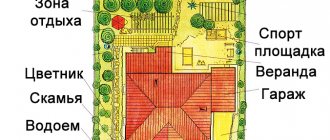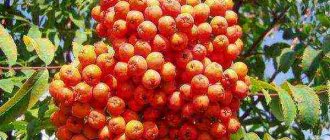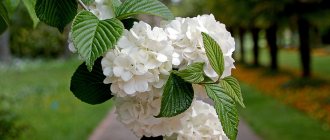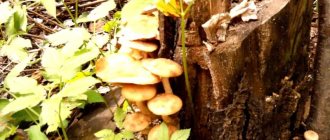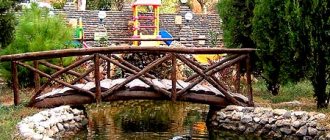- Rowan: botanical information
- Is the mountain ash edible?
- History of selection of sweet-fruited rowan
- The most delicious varieties of sweet-fruited rowan
- Personal experience of growing sweet-fruited rowan
Rowan is a very beautiful tree, familiar to everyone. And although its bright berries look appetizing and attractive, we know from childhood that we should not put them in our mouths. Yes, this will not bring any pleasure - they are too sour. But experienced gardeners know that there are hybrid sweet-fruited rowan trees that are not only very beautiful, but also tasty. I will talk about edible varieties of rowan and my experience of growing one of them in this article.
Sweet-fruited rowan - the most delicious varieties.
Rowan: botanical information
The genus Rowan (Sorbus) is represented mostly by small deciduous trees 10–20 meters high, although some species are shrubs. Representatives of the genus grow mainly in regions of the Northern Hemisphere with a temperate climate. The highest species diversity can be found in the Himalayas, southern Tibet and parts of western China.
In the middle zone, the most common mountain ash (Sorbus aucuparia) is found. This is a very variable species, but typically the trees have the following appearance: a tree with a thin trunk and smooth bark. The bark of young trees is yellowish-gray and shiny; in maturity it becomes gray-black with longitudinal cracks. The crown is loose, round in shape. The leaves are compound pinnate. It blooms from May to June with dense shields of small yellowish-white flowers with a noticeable specific aroma.
After flowering, orange-red fruits set, which ripen from August to October and are readily eaten by many species of birds. The plant is undemanding, frost-resistant, and inhabits abandoned and hard-to-reach places. Rowan rarely survives the age of 80 and is one of the shortest-lived trees in temperate climates.
Rowan diseases
Ella Sokolova, Candidate of Agricultural Sciences
Different types of rowan, very decorative during the flowering and fruiting periods, are widely used in landscaping. But often their aesthetic qualities are reduced due to infection by infectious diseases.
Leaf diseases
Brown spot (caused by the fungus Phyllosticta sorbi). In the second half of summer, reddish-brown spots with a red-violet border, often irregular in shape, appear on the upper side of the leaves. In the center of the spots, sporulation of the pathogen forms in the form of crowded small black dots. As the disease develops, individual spots merge and completely cover areas of the leaf surface. Different types of rowan are affected.
Gray spot ( caused by the fungus Phyllosticta aucupariae). In the second half of summer, gray spots with a wide dark brown border, round or irregular in shape, can be seen on both sides of the leaves. On the upper side of the spots, fungal spores form in the form of small, black dots. Often the spots merge and cover most of the leaf surface. Different types of rowan are affected.
Ring mosaic (pathogen: Tobaco ringspot virus). In early June, yellow rings with a green center, stripes and specks appear on the leaves. With severe development of the disease, the leaves become deformed, dry out and fall off.
Rust (caused by the fungus Gymnosporangium cornutum). In July, rounded, 2–5 mm in diameter, orange-yellow spots with dark brown small tubercles on the surface appear on the upper side of the leaves. On the underside of the leaves, on whitish spots, sporulation of the fungus forms in the form of brown cone-shaped outgrowths 1–2 mm long, arranged in star-shaped groups. Common rowan is affected.
Leaf diseases in some years lead to a significant reduction or complete loss of the decorative value of rowan.
Necrotic diseases of trunks and branches
Tubercular (nectria) necrosis (caused by the fungus Tubercularia vulgaris). On trunks and branches throughout the year, sporulation of the pathogen can be found in the form of pink, pinkish-red and dark brown round or oval pads with a diameter of 1–3 mm. Often they completely cover the affected areas of the trunk and branches.
Cytospor necrosis , or cytosporosis (caused by a fungus from the genus Cytospora). The affected bark turns yellow or does not change color, but in both cases it becomes covered with numerous small conical tubercles, which are receptacles for fungal spores. In the spring, the mucous mass of spores comes out and hardens on the surface of the bark in the form of golden-orange or red-orange drops, tendrils, and spirals.
Black necrosis (caused by the fungus Biscogniauxia repanda). Initially, the bark of the affected trunks and branches becomes yellowish, then cracks appear on it. From the cracks protrudes fungal formations with sporulation (stroma) in the form of numerous flat or concave black, hard, round pads with a diameter of 10–30 mm and a thickness of 5–6 mm. The disease is accompanied by the development of white peripheral rot in the wood.
Necrotic diseases affect mountain ash in unfavorable growing conditions, causing its weakening, a significant reduction in decorativeness, and often the death of trees. They pose the greatest danger to young trees.
Rot diseases of roots, trunks and branches
White sapwood (peripheral) rot of roots and trunks (causative agent - autumn honey fungus - Armillaria mellea). Rot from the roots rises into the trunk to a height of up to 2 m. Under the bark of the roots and the lower part of the trunk, white fan-shaped films of mycelium and dark brown branching flat cords (rhizomorphs) are formed. The fruiting bodies of the fungus develop in the butt part of the trunks and on stumps. Honey fungus affects trees weakened by various unfavorable factors.
White core (central) rot of trunks (causative agent - false polypore - Phellinus igniarius f. sorbi). Rot develops in trunks at a height of up to 3 m. The fruiting bodies are large, woody, perennial, with a dark gray surface and a wide, blunt red-brown edge.
Yellow-brown heartwood-sapwood (mixed) rot of trunks (pathogen: Phellinus punctatus). The fruiting bodies are prostrate, cushion-shaped, woody, up to 2–8 cm long, 2.5 cm thick, rusty brown or tobacco-colored. They form on dry roadsides, in frost holes, and at the site of broken branches.
In addition to the above, other rots are often found on mountain ash: yellow heartwood-sapwood (pathogen: oyster mushroom - Pleurotus ostreatus); brown sound (causative agent – fatty flake – Pholiota adiposa); white sapwood (pathogens: hairy (now more correctly coarse-haired) polypore - Trametes hirsuta, multi-colored polypore - Trametes versicolor).
Root rot damage leads to rapid weakening and drying out of trees. Trunk rot reduces the resistance of trees to windfall, which poses a great danger in urban environments.
Brown leaf spot Virus leaf mosaic Multicolored polypore
| Oily calyx | Cytospore necrosis (cytosporosis) |
Is the mountain ash edible?
Rowan berries are relatively edible, since they are undesirable to eat raw (especially in large quantities), because they have a strong astringent, diuretic (up to kidney damage) and laxative effect due to the high level of parasorbic acid. By the way, it is this acid that gives the fruits a specific bitterness.
However, after cooking (heat treatment, drying) or freezing, the berries become sweeter. Therefore, it is better to collect them after the first frost (for a similar effect, the berries can also be placed in the freezer).
Rowan berries contain vitamins A (even more than carrots) and C (more than red currants), as well as other beneficial substances, such as pectin, malic acid and tannins. Traditionally, the berries were used to prevent scurvy and treat gout, colds, flu and rheumatism.

Sweet-fruited rowan.
Protection from diseases and pests
The mountain ash variety Granatnaya is relatively resistant to diseases and pests. To protect rowan from diseases and insects, you should take care of timely prevention, and in case of damage, treat the plants with the necessary drugs and homemade infusions.
Table: prevention and treatment of mountain ash Pomegranate
| Name | Nature of the lesion | Fighting methods | Prevention | Period and terms of use |
| Rowan aphid | Damage and deformation of leaves | Treatment with 2% nitrafen solution (300 g/10 l of water) | Spring, before the buds open | |
| Treatment with 0.2% karbofos solution (75 g/10 l of water) | Summer, before ovaries form | |||
| Rowan gall mite | Damage to leaves, formation of swellings - galls | 0.1% Rogor-S solution (1 liter of working solution per 1 sq. m) | After bud break | |
| 1% solution of colloidal sulfur | Before flowering | |||
| Rowan moth | Damage to fruit pulp by caterpillars | Digging tree trunk circles. Collection and destruction of damaged fruits. | Autumn | |
| Treatment with 0.2% chlorophos solution (20 g/10 l of water) | 2 weeks after flowering ends | |||
| Moniliosis | Affects trees completely, forming dark gray growths | Treating wood with nitrafen (300 g/10 l of water) or copper sulfate (100 g/10 l of water) | The affected parts of the tree are cut off and burned. | Spring, before the buds open |
| Powdery mildew | Damage to leaves with a white coating, which leads to their death | Tear off and burn all affected leaves. Treatment with colloidal sulfur solution (30 g/10 l of water). | Before flowering | |
| Soap-soda solution: 10 liters of water, 3 tablespoons of baking soda, 3 teaspoons of liquid soap. | Every 4 days until completely gone |
History of selection of sweet-fruited rowan
Rowan was cultivated as a cultivated plant in Ancient Greece in the 4th century BC. Currently, selection of sweet-fruited rowan is carried out in Russia, Ukraine, Britain, Serbia, Italy, Germany and other countries. Initially, breeding work in many countries was carried out mainly on the species of domestic rowan (Sorbus domestica), and the common rowan was not of interest due to its bitter taste.
However, the situation changed when the sweet-fruited form of the mountain ash was discovered. Such a unique specimen was discovered in the Vladimir region in the village of Nevezhino. On the basis of this plant, the first sweet-fruited variety of mountain ash was created, called the “Nevezhinskaya” mountain ash. In the future - many domestic varieties (“Yellow”, “Red”, “Kubovaya”, etc.).
In Europe, the selection of sweet-fruited rowan was initially carried out on the basis of a tree discovered in the Czech Republic in the Altvater mountains (Moravia) in 1810. As a result of a spontaneous mutation, the fruits of this rowan lacked bitterness; this rowan received the name “Moravian” based on its place of growth.
Subsequently, breeding work continued not only on the basis of these forms, but also those later discovered. In addition, hybridization of Nevezhinsky and Moravian mountain ash was carried out. However, both cultivars have a common significant drawback - vigorous growth. And this feature makes it very difficult to care for and collect fruits.
Further selection of sweet-fruited varieties followed the path of crossing rowan with other pome crops (pear, chokeberry, medlar, hawthorn). A lot of work in this direction was started in 1905 by the great Soviet breeder Ivan Vladimirovich Michurin. His main work was crossing hybrids of rowan with chokeberry, apple, pear, hawthorn and medlar. The results of selection turned out to be successful and many of these distant hybrids subsequently became varieties (“Michurinskaya Dessertnaya”, “Burka”, “Likernaya”, “Granatnaya”, etc.). Later, breeder Tatyana Tikhonova, Michurin’s niece, received four more varieties of sweet-fruited rowan.
Currently, the priority areas in the selection of sweet-fruited rowan are: increasing frost resistance, increasing the content of vitamins and other nutrients, improving taste, increasing disease resistance and creating large-fruited varieties with a compact crown.
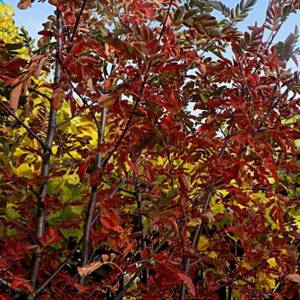
Autumn color of rowan.
Rowan Pests
Tamara Galasyeva, Candidate of Agricultural Sciences
Rowan pests include about 60 species of insects and herbivorous mites that damage the vegetative and generative organs of the plant: buds, leaves, shoots, flowers, fruits and seeds. Most rowan pests are polyphages, i.e. they feed and develop on other types of woody plants, especially those belonging to the Rosaceae family.
Leaf-eating insects
These insects damage buds, leaves, flowers and green shoots. The larvae of the rowan flower gall midge settle in the flower buds; as a result, the damaged buds do not bloom.
Leaves and buds become food for butterfly caterpillars and larvae of true and club-footed sawflies. Of the butterflies, representatives of several families were noted, including cutworms, moths, moths, moths, leaf rollers, moths, and white moths. On some rowan trees, caterpillars of the hawthorn butterfly, fruit spider moth and bird cherry moth live in spider nests. Caterpillars of these species build nests by fastening together several leaves on a branch or shoot with a web.
Miners and gall formers
Miners are insects whose larvae feed inside leaf tissue and form mines of various colors and shapes. Of the known species of insect miners, one can most often find the very narrow, ribbon-shaped, highly convoluted mines of the mountain ash moth.
Galls on rowan leaves are formed mainly by herbivorous mites. Galls in the form of whitish or brown felts on the lower and upper sides of leaves are formed by the gall felt mite. Galls in the form of small yellowish or reddish thickenings (elevations) of irregular shape belong to the pear mite.
sucking insects
Sucking insects feed on the sap of leaves, shoots, branches and trunks. These include several species of coccids (scale insects, false scale insects and mealybugs), aphids, psyllids and herbivorous bugs. Most of them can be found on other deciduous trees: willow scale, apple comma scale, acacia false scale, birch cushion. At the end of spring, the juices of a colony of rowan aphids are sucked out of the leaves. Damaged leaves bend, bend down, and curl into balls, often forming a large lump of leaves. With mass reproduction of sucking pests, curvature and drying of shoots, as well as deformation and yellowing of leaves, are observed.
Stem pests
Pests of wood and bark of trunks and branches are classified as xylophagous insects, or stem pests. Several species of mountain ash are known, including wrinkled sapwood, polyphagous wood borer, and narrow-bodied borers. They all settle on drying trunks and branches.
Pests of fruits and seeds
Pests of fruits and seeds are called carpophages. The larvae of the apple fruit sawfly and rowan moth feed on the fruit pulp; the seeds are eaten by the larvae of several species of hymenoptera insects from the families of shiny and dark seed-eaters.
Rowan fruits are pecked by many species of birds and eaten by mammals - from rodents to bears.
Elephant leaf galls Herbivorous mites Rowan baby moth Fruit spider moth Willow scale Apple sapwood
The most delicious varieties of sweet-fruited rowan
Research shows that each rowan variety has a unique set of biologically active substances. Sweet rowan berries are suitable for consumption in raw and processed form.
Rowan "Sugar Petrova" is a fast-growing tree, the fruits and leaves of which are similar in appearance to the common rowan. The berries are orange, sweet, and collected in huge clusters. One of the sweetest varieties of rowan. The variety is productive and frost-resistant. Tree up to 5 meters high.
Rowan "Titan" is a small tree (2.5-3 0m), it begins to bear fruit 2-3 years after planting. The harvest is bountiful. The berries are dark red, large, the taste is sweet and sour, slightly bitter, therefore they are most suitable for processing (jams, wine, compotes, sauces, etc.). Frost resistance is high. Created by crossing rowan, apple and pear trees.
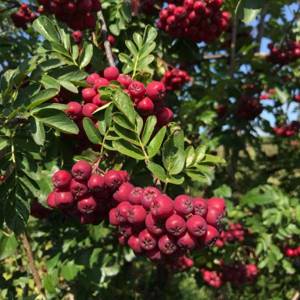
Rowan "Titan".
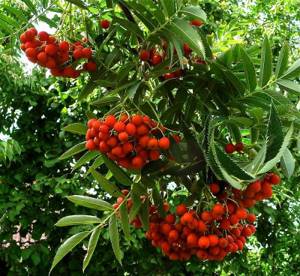
Rowan "Dodong".
Rowan "Burka" arose as a result of hybridization of the common rowan with chokeberry (chokeberry). The variety is distinguished by its very small tree size (1.5-2.5 meters) and compact crown. At the same time, it is very productive; up to 40 kg of berries can be harvested from one plant. It begins to bear fruit early and also begins to bloom early. Resistant to frost and disease. The fruits are large, dark red in color, the flesh is dense, dark, quite sweet (with a sugar content of 6-10%). At the same time, the berries contain a slight bitterness and a characteristic rowan aroma. Can be consumed raw and processed. The shelf life of collected fruits is 3-4 months.
Rowan "Likernaya" is a high-yielding early variety of rowan obtained by crossing rowan and chokeberry (chokeberry). The clusters are large, the fruits ripen in early August. The berries are dark red, shiny, medium size. Sweet to taste, but slightly bitter, suitable for processing. The tree is of medium height, frost-resistant, bears fruit early, and the harvest is plentiful.

Rowan "Pomegranate".
Rowan "Granatnaya" - the variety was obtained by crossing the common rowan and blood-red hawthorn. Tree of medium height, 3-4 meters. The fruits are large, slightly angular, dark red, yellow flesh with a rowan aroma. The taste is sweet and sour. Fruiting is early, abundant, medium-sized clusters. After picking, the berries are stored for 4-5 months. The variety is resistant to diseases.
Rowan "Dodong" is a variety from Korea. The fruits ripen at the end of August, are orange in color, quite large, pear-shaped. The taste is sweet and tasty, but the clusters are not very large, so the yield is not too high. Tree of medium height (8 meters). Frost resistance is high, but in severe winters young shoots can freeze. Grown as a highly ornamental species with beautiful feathery leaves that turn red in autumn.
Rowan "Scarlet Large" is one of the most popular varieties of rowan, obtained by crossing various types of rowan and pear. The fruits are very large (up to 4 grams), bright red, juicy. The taste is slightly piquant, but not bitter. It begins to bear fruit early, the harvest is plentiful, the clusters are very large. Tree of medium height, frost-resistant.
Varieties and types
Mountain ash
A tree that in its natural state (without growth-reducing pruning) reaches 15-20 m in height, in cultivation its growth is most often maintained at a level of up to 3 m by pruning or grafting onto an appropriate rootstock. Among the cultivars there are bush-like forms and forms with a weeping crown - with long branches descending to the ground. In the wild it grows in the second layer of the forest and in the undergrowth.
Rowan leaves in the spring, usually at the same time as birch. The leaves are large, up to 20 cm long, imparipinnate, consist of 11-15 oblong leaflets, the leaflets themselves are usually entire and pubescent at the base, young leaves are green with a brighter and darker upper side, in the fall they acquire a crimson-red color.
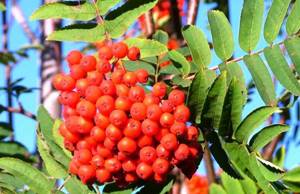
Common rowan, as a rule, blooms in late spring (more exact dates depend on the place of growth). The flowers are small, white or pinkish, collected in complex terminal inflorescences-scutes, located on short shoots.
The fruits are small: weighing up to 0.5 g and up to 1.5 cm in diameter, apple-shaped, spherical or pear-shaped; in wild forms they have a characteristic rowan color; in cultivated forms the color can be different: deep red, yellow, orange and even white. The seeds are sharp, triangular, very small. The fruits ripen at the end of summer.
The common rowan is very frost-resistant, tolerates slight shading, it is undemanding to the soil, but develops better on loose soils, and only does not tolerate swampy conditions. Growing wild, mountain ash is found throughout Ukraine and the European part of Russia to the Far North, but is most common in the central regions.
On the territory of Russia, the most common cultural form (sometimes considered a separate subspecies) is the Nevezhinsky mountain ash, which is sometimes incorrectly called “Nezhinsky”. On the territory of Ukraine, its distribution area is comparable to the distribution of another form - Moravian mountain ash, which came to us from the Baltic countries (this form was first discovered in the Sudeten Mountains in Moravia in the 19th century). Both Nevezhin and Moravian mountain ash belong to the sweet-fruited forms.
The Nevezhinskaya form (initial) is the tallest of the sweet-fruited mountain ash trees; it has all the characteristics of the wild mountain ash tree described above; but the color of the berries of the varieties may differ from the original one - it has orange-red (Kubovaya variety), orange-yellow (Yellow variety) and bright red berries (Krasnaya variety).
The Moravian form (the original, sometimes called sweet rowan) is a tree 10-12 m tall. In young specimens the crown is narrowly pyramidal, in mature specimens (in old age) it is broadly pyramidal. The branches are of medium thickness, the bark is gray.
The leaves of the Moravian mountain ash have a characteristic shape that distinguishes it from the leaves of other mountain ash and gives the crown an openwork appearance - the leaf is imparipinnate, up to 25 cm long, consists of 7-9 pairs of leaflets on a common petiole, relatively far apart (2-3 cm), spaced from each other; The leaflets themselves are up to 7 cm long, lanceolate, with a pronounced serrate edge.
The corymbal inflorescences are large, up to 15 cm in diameter; one inflorescence can contain up to 350 flowers. Moravian mountain ash blooms somewhat later than other species. The fruits are up to 1 cm in diameter, round-oval, scarlet-red, with juicy sweet and sour pulp, paler in color than the peel. They are somewhat inferior in taste to the fruits of the Nevezhin rowan, but the Moravian rowan is superior to it in decorativeness.
In addition, the type of rowan has quite a few decorative forms: Russian - differs from the main form in larger and wider leaves, as well as large fruits with a not too bitter taste; pyramidal - so named because of the narrow pyramidal crown with upward-pointing branches; weeping - distinguished by thin, long, drooping branches; Beisner form - distinguished by bright red young shoots and leaf petioles with pinnately lobed leaves; Fifeana form - distinguished by yellow fruits.
Varieties of mountain ash
Angri. The variety was created on the basis of the Nevezhin form of mountain ash. Tree 3-3.5 m tall. It begins to bear fruit from the end of August, fruiting is regular. The fruits are numerous, weighing 1.3-1.5 g, rowan-red with a yellowish tint. The taste is sweet and sour, without bitterness or astringency, the content of vitamin C, carotene and P-active substances is above average. Keeping quality is low - up to 1 month.
Bead. The variety was created on the basis of the Nevezhinsky form of mountain ash from the Kubovaya variety. Tree 2.5-3 m tall. It begins to bear fruit at the end of August. The fruits are small, weighing about 1 g, ruby red, shiny.
The taste is sweet and sour (sourer than the previous variety, due to which the fruits are often used in processing as an acidifier), without bitterness or astringency, and is considered one of the best among rowan trees. Shelf life is about 4 months. Resistant to unfavorable climatic factors, including sudden temperature changes, drought-resistant.
Wefed. The variety was created on the basis of the Nevezhin form of mountain ash. Tree 2-3 m tall. It begins to bear fruit in mid-August 4-5 years after planting. The fruits are numerous. Weighing 1.2-1.3 g, orange-red, slightly shiny. The taste is sweet and sour, there is no bitterness or astringency, it is considered one of the best among mountain ash. The content of vitamin C and P-active substances is very high (96 and 620 mg per 100 g).
Kubova's daughter. The variety was created on the basis of the Nevezhinsky form of mountain ash from the Kubovaya variety. Tree 2.5-3 m tall. It begins to bear fruit in mid-August. The fruits weigh about 1 g, bright orange, often with a reddish blush, shiny. The taste is sweet and sour without bitterness or astringency. Contains a lot of vitamin C (100 mg per 100 g). Keeping quality is insufficient - about 1 month. Resistant to unfavorable climatic factors, including sudden temperature changes, drought-resistant.
Sorbinka. The variety is based on the Moravian form of rowan. Tree 3-3.5 m tall. It begins to bear fruit at the end of August, 5-6 years after planting. The fruits are large, weighing up to 2.6 g, collected in large scutes (the total mass of the scute is about 300 g), bright red with yellow dots, slightly shiny. The taste is sweet and sour with a slight bitterness. The content of vitamin C and P-active substances is very high (114 and 690 mg per 100 g). The shelf life of the fruit is about 1.5 (to 2) months. Resistant to unfavorable climatic factors, including sudden temperature changes, drought-resistant.
Amur rowan
Tree up to 4-8 m high. The trunk is straight, the bark of the trunk and adult branches is gray with dark horizontal “lentils”; on young shoots the bark is reddish, with white “lentils”.
The leaves are up to 21 cm long, compound, odd-pinnate, consist of 5-7 linear or broadly lanceolate, unequal in size and shape leaflets up to 5 cm long: the lower leaflets are petiolate entire, the upper ones are sessile with a sharply serrated edge. The structure of the flowers and inflorescences is similar to that of the mountain ash, the fruits are up to 9 cm in diameter, orange-red, and are characterized by the presence of the smell of bitter almonds.

Growing wild, Amur rowan is found in the southern part of the Far East, Northern Manchuria and North-East Asia in forests, undergrowth and on the edges; It is cultivated mainly in the eastern regions of Russia. It is characterized by high frost resistance and resistance to adverse climatic factors, including sudden temperature changes.
Rowan elderberry
A shrub up to 2.5 m tall (usually about 1.5 m, making this species most suitable for creating hedges), with a round or ovoid crown. Shoots are relatively sparse, straight; on young branches the bark is gray with brightly visible “lentils”; on adults it is bare, dark brown, with a bluish coating.
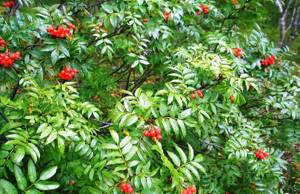
The leaves are imparipinnate, up to 18 cm long, located on reddish petioles with lanceolate stipules, consist of 7-15 broadly lanceolate leaflets, with sharply serrated edges, the leaves are dark green, shiny on top. The inflorescence is a complex shield, on the branches and pedicels there is a slight reddish drooping, the flowers reach 1.5 cm in diameter, are reddish or white in color, and look very decorative.
The fruits are spherical, bright red, up to 1.5 cm in diameter, juicy, sweetishly acidic, without bitterness, with a pleasant aroma, and can be stored on the bushes until spring. May bloom twice. Elderberry rowan is a winter-hardy and most drought-resistant species of semi-cultivated rowan trees.
Growing wild, elderberry mountain ash is found mainly in the Far East in the Khabarovsk Territory, Kamchatka and along the Okhotsk coast, as well as on Sakhalin and the Kuril Islands; it is also common in Korea and Japan.
Personal experience of growing sweet-fruited rowan
Even wild mountain ash evokes the most positive feelings in me. It has really attractive carved foliage that bursts into flames in the fall, and pretty berries. In general, the tree has a very delicate and feminine appearance. Therefore, as soon as I learned about the existence of decorative and edible varieties with interesting fruit colors, I immediately became eager to plant such a specimen in my garden.
I purchased a small seedling of the sweet-fruited mountain ash variety “Granatnaya” from a nursery seven years ago. The dacha where I planted the young tree is located in the Voronezh region; the soil in this area is not very fertile. The tree grew very slowly, despite regular feeding. The foliage of this variety is very different from the common rowan; on one tree you can see both whole leaf blades, like an apple leaf, and pinnate leaves, individual segments of which can also be fused, which looks very original and decorative.
I didn’t get the first harvest from my rowan trees until the sixth year after planting. And the berries of this crop impressed me very much. Firstly, they were much larger than the species, like small apples collected in huge bunches. And, secondly, the berries of the “Granatnaya” variety turned out to have a completely unusual deep burgundy-red hue, which I could describe as the color of a noble red wine. The pulp inside the berries turned out to be bright yellow.
I have never tried fresh rowan of the species, so it is difficult for me to judge how superior it is to the varietal variety. But if you compare the sweet-fruited rowan with the usual berries (raspberries, currants, etc.), then rowan is still seriously inferior to them, and because of its specific taste, you can’t eat much of it raw.
Therefore, sweet-fruited rowan for me is still mainly an ornamental plant. After all, it has extremely bright and multi-colored autumn colors. During the ripening of the berries, I use bright bunches of original colors to decorate the interior. As for food use, I add a small amount of this rowan to the compote for vitaminization. I freeze part of the harvest for the winter to make healthy tea. But at the moment my rowan does not produce too abundant harvests.
Reproduction
Pomegranate rowan propagates by grafting or budding (cuttings, arc layering or root suckers). It is best to carry out budding at the end of July in order to be able to prune the grafted plants in mid-spring (April). To prevent the trunks from being twisted, pruning should be done on a spike. The resulting cuttings can be grafted onto ordinary rowan in the spring, thereby ennobling it and improving its varietal qualities.
Grafting of pomegranate varieties can be done in the following ways:
- into the cleft;
- in a side section;
- in the butt.
Comment! Usually the cuttings grow together well, without the formation of any large thickenings at the junction.
Reproduction by arc layering is carried out as follows:
- The lower branches bend to the ground.
- Secure with pegs. The end of the branch should be slightly curved.
- The branch is sprinkled with soil.
It is necessary to ensure that the soil is always well moistened and loosened. You can separate the cuttings from the tree after 2-3 years.
Common rowan bush form
Rowan, or common rowan, is a well-known plant, which, as a rule, is found in the form of a tree; bush rowan is somewhat less common. The height of the rowan tree is usually from 6 to 15 m. The rowan tree has a loose crown and drooping young branches. The characteristic leaves of rowan are alternate, with 5-7 leaflets having a lanceolate shape. However, the most striking distinctive and decorative feature of rowan is, of course, its bright red berries, collected in clusters.
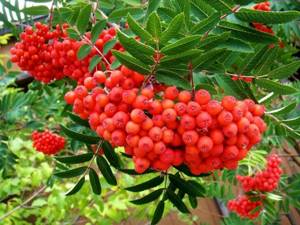
Under natural conditions, mountain ash grows throughout the European part of Russia, with the exception of the Far North. Most often, rowan can be found in the undergrowth of mixed and coniferous forests, on the edges and clearings. Rowan has long been a cultivated plant, and as such it can be seen in garden and park areas, as well as protective forest belts.
Common mountain ash blooms in May-June; its flowers are small, white, and have a rather unpleasant odor. In September-October, bright red or orange-colored fruits ripen on the rowan tree, which remain on the rowan branches until late winter. Rowan fruits can be eaten; they are also valuable medicinal raw materials. A rowan shrub planted on a plot begins to bear fruit at the age of 5-7; the harvest can be obtained every year, but sometimes you have to wait 1-2 years for a good harvest. An adult plant, several decades old, can produce more than 50 kg of berries.
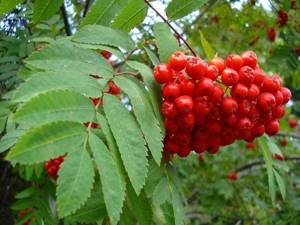
Rowan tolerates cold and drought well, but requires good lighting. In the shade, rowan almost does not bear fruit. The advantages of rowan include its rapid growth, which is especially noticeable when planting a rowan bush - it can grow by 0.5 m in a year.
Rowan has long been a symbolic plant in Rus'. It was believed that its fruits could protect a person from troubles; for this purpose, rowan branches were hung in houses and on gates. The rowan plant is believed to bring peace and happiness, so in the past it was always planted in close proximity to the house. Rowan can bring much more tangible benefits. It is known that rowan fruits have laxative and hemostatic properties, they can have antidysenteric and contraceptive effects, and they contain a large amount of vitamins. Rowan berries are used in the form of an infusion, valuable juice is obtained from them, the berries can be dried, jam and compote can be made from them.
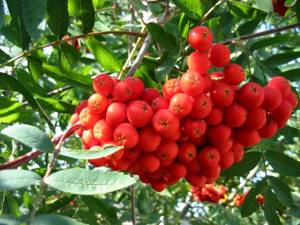
Homeland of rowan
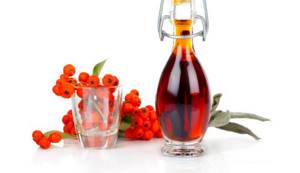
The homeland of rowan is Europe and Anatolia, located in Asia Minor. The “ancestor” of edible rowan is the common rowan, which has been used since ancient times for various needs: both as a food product and as a medicinal plant.
Around 1810, a mutant of the common rowan was discovered - edible rowan, the berries of which were practically devoid of the bitterness inherent in rowan. At the beginning of the twentieth century, this variety began to be bred and sold in tree nurseries, and thanks to the achievements of modern breeding, new varieties were created - with larger berries of different and sometimes unusual colors, with a very pleasant taste.
How is it useful?
The fruits of rowan (by the way, botanists consider them not berries, but apples) contain sorbitol, ascorbic and other organic acids, vitamins P and K, carotene, bitterness, pectins and other valuable compounds. In medicine, rowan is most often used as a multivitamin.
In addition, sorbitol has a disinfectant effect, which is why it is often used as a food additive – a preservative. The fruits and even branches of rowan protect water from spoilage. They used to be used on hikes to prevent the water from blooming and to have a pleasant taste. In folk medicine, rowan is used to treat diseases of the liver, bladder and kidneys, gout, rheumatism, hemorrhoids, gastritis with low acidity. A decoction of the fruit is a good diuretic, diaphoretic and laxative. Warts are removed with fresh rowan juice.
It is also known that rowan reduces cholesterol levels in the blood, reduces the permeability and fragility of capillaries. Juice and infusion are useful for hypertension, tuberculosis, and during menopause.


